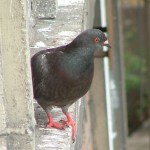pigeon
Sara Letzner had humans compete against pigeons in a behavioural experiment. Photo from: Ruhr-Universitat at Bochum
A new study conducted by Drs. Sara Letzner and Onur Gunturkun (Ruhr-Universitat at Bochum) as well as Dr. Christian Beste (Technische Univeritat at Dresden) shows that pigeons are better than humans when it comes to multitasking. Their findings were published in Current Biology.
The findings from the study show that the mammalian cerebral cortex, with all of its cortical layers, is not the only type of brain that can perform complex tasks as birds do not have a…
This is such a beautiful award-winning image of the complex vascular networks in a pigeon. The image was captured using CT scan technology and a novel contrasting agent called BriteVu that allows visualization of even tiny capillaries. This image was captured by Scott Echols who is a member of the Grey Parrot Anatomy Project, whose goals are to create technologies to study animal anatomy. The complex capillary network located in the neck of this pigeon is important in helping the animal regulate body temperature. Dilation of these blood vessels allows the birds to dissipate…
A study recently published in the Proceedings of the National Academy of Sciences provides evidence that pigeons can learn to recognize words. That is after the birds were trained over a period of 8 months. According to the study authors "The pigeons’ performance is actually more comparable to that of literate humans than baboons’ performance."
To read, we must be about to decode letters and the sounds they make as well as orthographic knowledge to recognize words by sight. Although our lineages split over 300 million years ago, pigeons (like humans and baboons) possess orthographic…
Photo of a pigeon (Columba livia) by Wardrin - Own work, GFDL, https://commons.wikimedia.org/w/index.php?curid=5739797
With reported lead poisonings in cities such as Flint Michigan, methods to detect risk of exposure are desperately needed. Since pigeons live in close proximity to humans, could pigeons be the 'canary in the lead mine'? Researchers at Columbia University in New York City measured the concentrations of lead in the blood of 825 ill or injured feral pigeons to determine whether the animals could serve as bioindicators of levels in the environment. Their results were …
Image of dodo bird skeleton and model By BazzaDaRambler - Oxford University Museum of Natural History ... dodo - dead apparently.Uploaded by FunkMonk, CC BY 2.0, https://commons.wikimedia.org/w/index.php?curid=20054563
Using computed tomography (CT) scans of an intact skull, researchers have discovered that extinct dodo birds (Raphus cucullatus), despite having a rather silly name, were actually pretty smart. Well, as smart as a pigeon at least, and pigeons are pretty smart. Dodos likely also had a good sense of smell based on measurements of the olfactory portion of the skull. This…
You are probably thinking, whose bird-brained idea was that?
Well, as it turns out, a new study published in PLOS ONE shows that pigeons can be trained to accurately differentiate cancerous versus healthy tissue biopsies. This is because the process of diagnosing cancer involves visual screening of MRIs an biopsies and pigeons use similar visual processing as humans. Moreover, according to the article, pigeons are able to learn and memorize over 2000 images, a skill that likely helps in identifying cancerous cells.
In a quote from Scientific American, study author Dr. Richard Levenson (…
I came across this interesting video today from Animal Wire that shows a population of catfish caught hunting pigeons on land:
Who knew that catfish had more in common with cats than just their whiskers.
I know what I'm doing tonight! I just heard about a special called "What Are Animals Thinking" that will be airing tonight on NOVA ScienceNOW. To check local listings, click here.
Watch What Are Animals Thinking? Preview on PBS. See more from NOVA scienceNOW.
Do animals create art? So far, this seems a uniquely human ability.
But do animals have a sense of the aesthetically pleasing? What about the ability to judge and critique art? Can an animal decide if a given work of art is beautiful or ugly? What is beauty in the first place? All good questions.
Shigeru Watanabe of Keio University in Tokyo wanted to investigate the questions, with pigeons. Did he introduce them to the works of Picasso? Or Rembrandt? Romero Britto? No. He used art created by children.
Figure 1: Your kid's newest art critic.
Before we get into his experiment, lets take a…

